INSIGHTS
Alarm monitoring is one of the oldest security businesses. When away from one’s home or business, alarm monitoring offers the reassurance of knowing someone is vigilantly standing by. Should the worst happen — fire, broken window or intrusion — professionals will have taken the appropriate response. The right authorities will be notified by alarm-monitoring operators, providing peace of mind. Global security monitoring revenues totaled about US$40 billion, according to First Research in a July report. This encompasses residential and commercial alarm monitoring. Europe and the U.S. are the largest security system markets, dominated by ADT Security Services, Securitas and G4S. Effective alarm monitoring requires a stable infrastructure, robust enough to not miss a single signal. However, wired or wireless transmission media provide unique benefits and drawbacks. Redundancy depends on multiple technologies. Signal priority makes sense of which alarms are most important. The majority of alarms are false, wasting the time and resources of law enforcement and other first responders. Newer systems have the infrastructure to support audio or video monitoring as secondary verification. However, these systems require more bandwidth or a complete system overhaul, as more customers rely on mobile devices.
Alarm Monitoring Improves Awareness Through More Services
Date: 2011/09/15
Source: a&s International
Government Monitoring
City surveillance projects are a perfect fit for alarm and video monitoring, with a team on standby to respond in time. The London Borough of Bexley selected Siemens Building Technologies to run its town center monitoring center. Siemens performed all video surveillance services and took over the operating center in April 2010. The Borough of Bexley became London's safest borough this February, up from fifth place. Video monitoring is more efficient and has increased the amount of evidence provided to the police by 17 percent, according to Siemens Building Technologies in a prepared statement. Camera downtime has also been reduced, with asset ability running at 99.8 percent.
 Public space surveillance operators must be licensed by the UK government through the Security Industry Authority. This ensures operators are competent to undertake their role and includes criminal record checks. “Considering town center schemes , a key trend is the rollout of virtual matrix solutions,” said Tony Allen, Chairman of the Security Equipment Manufacturers Section, British Security Industry Association. “The advantage here is that these are able to seamlessly bring together geographically dispersed digital and analog equipment, from multiple locations, allowing control room operators using a map-based graphical user interface to point and click on a specific areas so incidents can be tracked and dealt with in a timely manner.”
Public space surveillance operators must be licensed by the UK government through the Security Industry Authority. This ensures operators are competent to undertake their role and includes criminal record checks. “Considering town center schemes , a key trend is the rollout of virtual matrix solutions,” said Tony Allen, Chairman of the Security Equipment Manufacturers Section, British Security Industry Association. “The advantage here is that these are able to seamlessly bring together geographically dispersed digital and analog equipment, from multiple locations, allowing control room operators using a map-based graphical user interface to point and click on a specific areas so incidents can be tracked and dealt with in a timely manner.”
Registering Alarms
 An alarm center is all about getting the signals. Most signaling communication is usually by public switched telephone networks (PSTN), as it is the cheapest option, said Brian Kelly, MD of Bold Communications, a provider of alarm-monitoring software. “However IP/GPRS is becoming more popular, as it is more secure and can save money.”
An alarm center is all about getting the signals. Most signaling communication is usually by public switched telephone networks (PSTN), as it is the cheapest option, said Brian Kelly, MD of Bold Communications, a provider of alarm-monitoring software. “However IP/GPRS is becoming more popular, as it is more secure and can save money.”
Commercial sites can opt for either phone lines or IP, but insurance requirements typically mandate higher-grade connections — at least Grade 3 or 4 — with dual paths, Kelly said.
Lamont added both IP and cellular communications are relatively well-established transmission methods, but one is yet to rise above the other for alarm monitoring. .
Redundancy can be done in a number of ways, to make sure alarms are not missed. ADT operates two alarm-receiving centers in Manchester that are each large enough to house all staffers, should something happen to either building. “Each has two telephone providers into the building,” said Dominic White, Head of the UK Customer Service Centre, ADT Security Services, which covers the U.K. and Ireland. “If British Telecom goes down, a signal could go in on another provider.” .
 Both sites have diesel generators connected to uninterruptible power supplies, along with servers duplicated across sites, to keep downtime to a minimum. “If you take an alarm signal from your home, that alarm presents to both alarm-receiving centers, then the system decides which center takes the alarm,” White said. “So we have no single point of failure to the customer.” .
Both sites have diesel generators connected to uninterruptible power supplies, along with servers duplicated across sites, to keep downtime to a minimum. “If you take an alarm signal from your home, that alarm presents to both alarm-receiving centers, then the system decides which center takes the alarm,” White said. “So we have no single point of failure to the customer.” .
Redundancy also featured into Mace's central station, which receives signals from three different telecom providers, as well as copper and fiber signals on a gigabit network. “We invested heavily on a platform to take all the things that might come in,” Hertel said. The platform supports alarm monitoring, along with medical monitoring and geolocation devices from vehicles. .
Once the alarm reaches the monitoring center, operators must decide how to respond. Signals from sites will be verified and filtered before reporting them to police, Yap said. The majority of signals sent from a monitored site are not true alarms, but usually warnings about low battery, AC failure or sensor trouble.